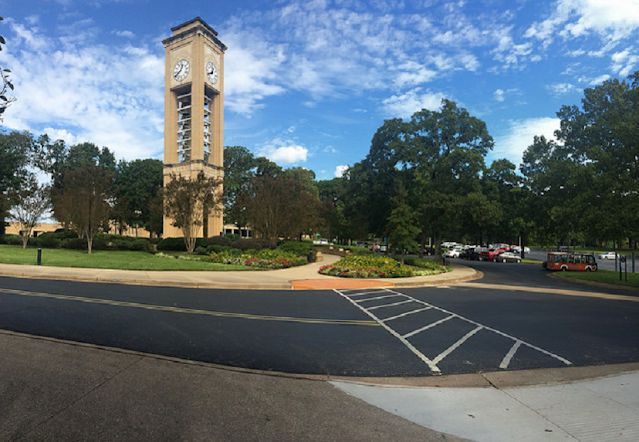OPINION: UT-Tyler Should Abandon 'JEDI' Diversity
Riter Tower at The University of Texas at Tyler (Source: James Hescock)
I’ve been looking through the internet lately trying to understand what the big deal is behind "Diversity, Equity and Inclusion". I did this because, back in February, Stephanie Fenter, UT-Tyler’s vice president of strategic planning, announced to student government that the draft of the university’s new strategic plan has a provision to make Justice, Equity, Diversity and Inclusion (or “JEDI”) a strategic university priority.
“We are committed to growing our student body by advancing a culture that cultivates justice, equity, diversity and inclusion,” she told the student assembly.
What Is JEDI?
JEDI is a next step from traditional Diversity and Inclusion (DI) efforts which have been in higher education for years. It takes this same ethic—which is the equalization of outcomes—one step farther. Many regard JEDI as the next evolutionary step of social justice activism in higher education.
For example, as the argument goes: where diversity and inclusion celebrated racial minorities’ participation in higher education as good for the whole university community, JEDI goes a step further and prioritizes people of color’s advancement for its own sake (irrespective of the alleged good to the whole).
So, in other words, JEDI expresses an even greater commitment social justice interventionism than its DI predecessor. Therefore, when I heard that UT-Tyler may now adopt a JEDI orientation, naturally, I wanted to know more.
Structural Determinism
As it turns out, beneath JEDI and DI initiatives is, fundamentally, the philosophical outlook of structural determinism.
Structural determinism is the idea that oppressive social structures present an influence upon a person so great that he is unable to be anything other than what the environment allows him to be. In structural determinism, environment is the primary causal factor in disparities among racial groups.
So for example, a poor black child who grows up in an urban ghetto is unable to attain the same success as white children because the external challenges in his environment will not allow it.
Conversely, a white child who grows up wealthy in a suburban neighborhood achieves success, not as a result of his personal ethics, but only as a result of his environment. Therefore, the “structure” of the environment “determines” the outcome of a person’s life. Therefore, the term: “structural determinism”.
Equality of Outcome
Now, this deterministic outlook comes through strongly in much of the JEDI literature on the internet. This is because structural determinism is one of the key foundations to the JEDI orientation. Furthermore, as I wrote above, the equalization of outcomes is what JEDI curriculum has as its main goal.
For example, I learned that the emphasis on inclusion in higher education is a result of policymakers’ goal to arrive at equal outcomes among whites and students of color. Hence, the effort to equalize outcomes is the goal behind other efforts to promote inclusion, such as to enroll more students of color, to find representation for black and Latino students on university committees, or to see more racial minorities on university honor rolls and so forth.
This effort to equalize outcomes is what is really behind the efforts towards “inclusion.” So, all of these things, inclusion and diversity, are an effort to attain equal outcomes between racial groups and beneath the aim for equality of outcomes is a broad adherence to the belief in structural determinism.
What Is Interventionism?
Therefore, in order to counteract the effect of these negative social forces on people of color, policymakers (and often liberal school administrators) engage in what’s known as Interventionism.
That is, they intervene on behalf of people of color to do for them what they supposedly could not do for themselves, which is to advance them into situations of advantage. Affirmative Action is a classic example of interventionist policy. Other examples are food or housing programs, as well as economic financial aid for low-income students.
Interventionists (in this case, JEDI interventionists) also intervene to check white influence. Again, they do this to obtain equal outcomes between the two groups, so they will limit white influence, as well. (Think: racially segregated campus spaces.) So interventionism is rampant among JEDI supporters given their goals to equalize outcomes among racial groups.
In the end, their belief in structural determinism by race gives rise to the tremendous amount of interventionism that we see on the higher-education level for people of color.Analysis
This sweeping adoption of interventionism and its underlying determinism is so extensive that I believe we are now starting to see a wide scale denial of the ontological reality of the individual. In other words, the truth that one person is separate and unique from another. The idea that they stand apart from the environments they may inhabit. Structural determinism denies the individual as someone who is separate and unique from his environment.
To put it another way, the rising popularity of structural determinism among higher education officials, signified by their adoption of JEDI policy, highlights the wave of underlying despair that is coming over American higher education due to the defeatist outlook in Leftist ideology. The Left’s failure to provide hope leads people to rely upon a defeatist worldview to make sense of the world.
It is important that we return to a belief in the uniqueness of the individual. This includes belief in his remarkable ability to stand apart from his environment.
We must embrace Compatibilism which is the belief that while human beings are certainly subject to structural forces, each individual is still morally responsible for his own choices.
UT-Tyler should abandon its support for JEDI curriculum and rededicate itself to affirm the individual as an ontological reality. This belief provides students with a rational basis to hope in the face of adversity.
Otherwise, the defeatism within structural determinism will deprive students of a rational basis to hope for a better future, since as unique individuals, they have every reason to have it.
Enjoyed this post? Never miss out on future posts by following me.

.jpg)


Comments
Post a Comment